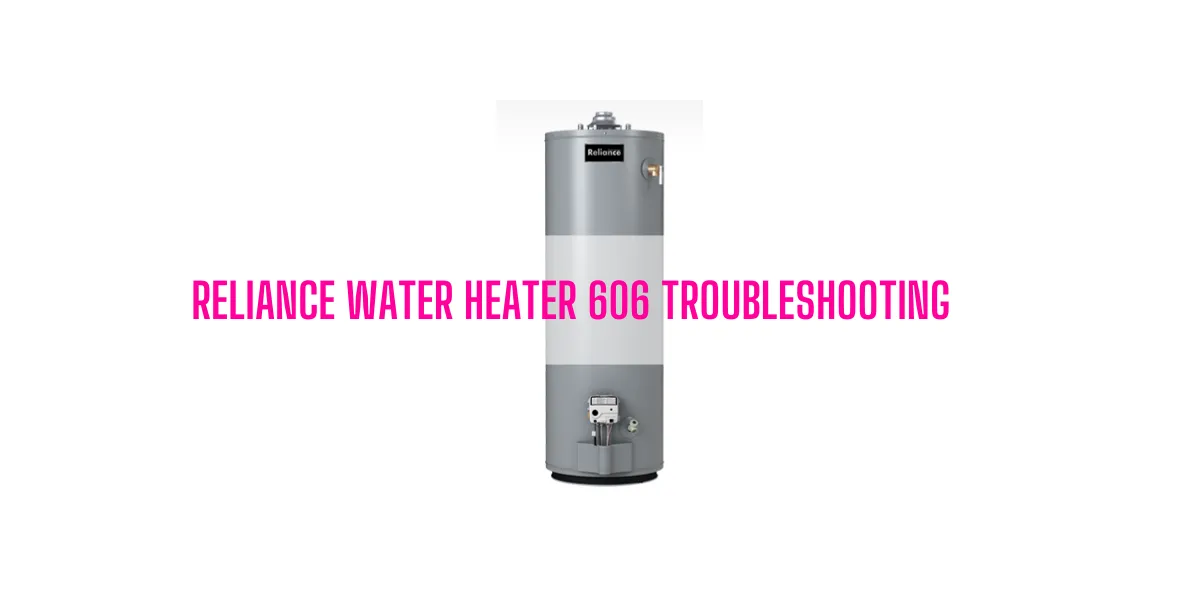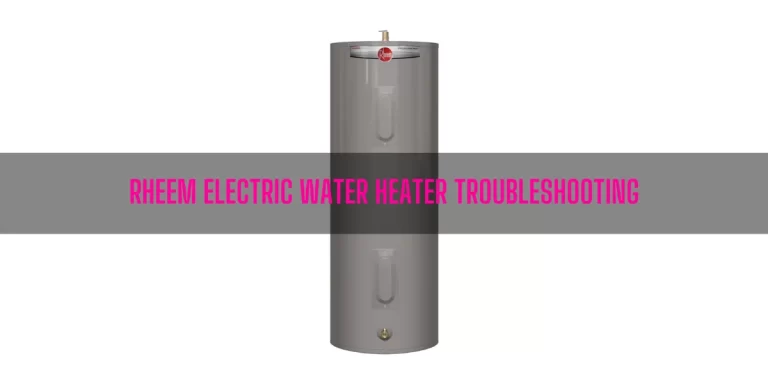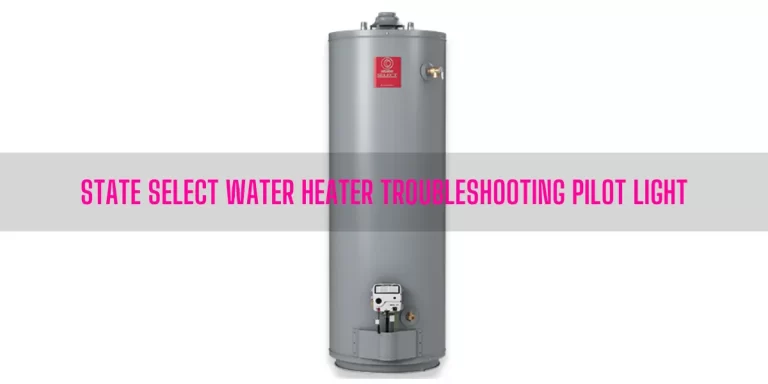Reliance Water Heater 606 Troubleshooting [Complete Guide]
This guide on Reliance Water Heater 606 Troubleshooting will provide the solutions to these common problems:
- Burner won’t ignite
- Smelly water
- Burner flame turns yellow
- Pilot light won’t light or stay lit
- High operation costs
- Drip from relief valve
- Condensate
- Thermostat fails to shut-off
- Burner flame floats and lifts off ports
Without further ado, let’s dive in and resolve the issue to enjoy the comfort of warm water.
Table of Contents
Reliance Water Heater 606 Troubleshooting [9 Problems & Solutions]
This chapter will walk you through the step-by-step procedure to solve 9 common problems of your Reliance 606 Water Heater.
1. Burner Won’t Ignite
The burner of your Reliance Water Heater won’t ignite in the light of the following reasons:
- Pilot is not lit.
- Set the thermostat too low
- No gas
- Pilot line gets clogged
- Main burner line gets restricted by dirt or gunk
- Thermocouple is at fault
- Bad gas control/thermostat
- You may install the unit in a confined area
How To Fix:
Start by lighting the pilot if the pilot is not lit. To light the pilot, follow the instructions I described below:
- Set the gas control/thermostat knob to the off position.
- Wait 5-10 minutes to let the gas clear out.
- Turn the gas control or temperature knob counter-clockwise to Pilot.
- Press and hold down the temperature knob all the way in. While holding down the gas control knob in, keep pressing the igniter button repeatedly for 90 seconds or until the status light blink comes on.
- When the status light comes on or starts blinking, release the gas control/temperature knob. Then, set it to your desired temperature setting.
- If the status light doesn’t come on at the first lighting attempt, try three more times to light the pilot. Ensure you wait at least 10 minutes between each attempt. Don’t hesitate to call a certified technician if you fail to light the pilot after three lighting attempts.
Secondly, ensure you set up the thermostat or temperature knob to higher temperature settings. To increase the temperature output, just turn the thermostat knob to your desired setting.
Thirdly, assure that the unit receives gas to the burner. No gas will not flow to the burner if you don’t fully open the gas shut-off valve. Besides, size up the gas line wrongly or bad gas meter will also cause the unit to not get sufficient gas for combustion.
So, check the manual gas shut-off valve on the gas line and set it to the on position. Then, make sure you size up the gas line according to the manual. Also, ensure the gas meter is functional and it can handle the entire BTUs load of all gas appliances in the building.
To inspect both the pilot line and the burner line, you should disassemble the unit. That’s why I recommend you call a professional to release the blockage both from the pilot line and the main burner line.
Next, head over to inspect the thermocouple. If it’s at fault, you should replace it. And the following tutorial will help you replace the thermocouple:
Nonetheless, the burner will not come on if the gas control/thermostat gets defective. In this case, you should replace the gas control with a new one. Fortunately, I described how to replace the gas control (step-by-step) in this article: Reliance 606 Water Heater pilot won’t stay lit.
And last not least- ensure you install the unit in a well ventilated area.
2. Smelly Water
Rotten egg smell in the hot water! If this is the issue you encountered, you are not alone.
Every tank water heater has at least one anode rod, which protects the tank against corrosion. And your Reliance Water Heater is not an exception to that.
Certain water conditions will cause a reaction between the anode rod and the water. As a result, you will get smelly water out of the unit. Generally, the following factors will be responsible for the odor to develop:
- The supply water you get is sulfate-concentrated
- Lack of dissolved oxygen in the water
- A sulfate reducing bacteria gets accumulated within the water heater
- An excessive amount of active hydrogen in the tank
How To Fix:
To eliminate or reduce the smelly water, you can replace the existing anode rod with a new one that has less active materials.
You can also chlorinate the water heater tank and the water lines to reduce the odor of the water you get out of the unit.
If the replacement of the anode rod and the chlorination method doesn’t bring any luck, chlorinating the water supply can solve the smelly water issue.
3. Burner Flame Yellow
The burner flame turns yellow if the unit gets insufficient secondary air. Apart from this, low gas pressure, clogged flue, and blockage in the main burner orifice can cause the yellow burner flame.
How To Fix:
To begin with, I suggest you verify the water gets sufficient secondary air. In other words, ventilate the area where you installed the unit by opening the window and the door.
In addition, check the inlet gas pressure. The gas pressure on a proper functional unit should be between 4” WC to 14” WC. If the pressure goes out of range, you must call a certified professional to solve this issue.
Furthermore, a clogged flue vent can also be responsible for the yellow flame. In this case, inspect the flue vent for blockage. You can use a flue vent cleaning tool or isolate the flue venting pipe to release the restrictions from there.
Finally, take a look at the main burner orifice for restrictions. I recommend you call a certified plumber to clean the burner orifice as it requires to disassemble the unit.
4. Pilot Light Won’t Light or Remain Lit
Doesn’t the pilot light stay lit? Then, one of the following reasons is responsible for the pilot light to not remain lit:
- Air in the gas line
- No gas or low gas pressure
- Dirt in the gas lines
- Pilot line or orifice gets clogged
- Thermocouple connection comes loose
- Bad thermocouple
- Defective thermostat
- Bad igniter
Luckily, I broke down each of these culprits in my previous article on Reliance 606 Water Heater Pilot Won’t Stay Lit. So, check out that article and solve the pilot light issue.
5. High Operation Costs
We know how blessed a hot water is on the chilly days of winter. But that blessing could turn into a curse if it takes a lot of money to operate, especially in this recession period.
Several things are to blame behind high water heater operation costs, including:
- You may operate the water heater at higher thermostat setting
- Sediment buildup in the tank
- Water heater is too small for the job
- Leaking faucets
- Wasted hot water
- A lengthy exposed piping
- Cracks in the dip tube
How To Fix:
Let’s start from the way you operate your water heater. If you always operate the unit at higher settings like above 130, it will raise the operating cost. To reduce this cost, it is recommended to run the unit at 12o F.
Secondly, check the bottom of the water heater tank. If there is scale buildup on the tank, the unit will take more time to heat the water. To avoid this issue, you should drain the water heater every six months. Follow the below procedure to drain your Reliance Water Heater like a pro:
- Shut off the gas supply to the unit at the manual gas shut-off valve.
- Turn on a nearby hot water fixture and let it open until the water cools down.
- Close the cold water inlet valve.
- Attach a drain hose to the drain valve and place the end of the valve to the nearest floor drain.
- Open the water drain valve to drain water from the tank. Flush the water as much as you need to remove the scale buildup from the bottom of the tank.
- Close the drain valve, fill the heater with water, and restart the unit following the instructions mentioned in the manual.
Thirdly, install a water heater that can meet your usage demand. It is always best to consult with a professional before choosing a water heater for your home.
Fourthly, take your eyes at the water faucets. If they are leaking, you must fix them up. Be sure you don’t waste the hot water or use it unnecessarily. Otherwise, you need to pay for it.
In addition, if the piping runs a long distance, you must insulate the piping.
Lastly, check the condition of the anode rod. If it gets rusted, replace it with a new one. Fortunately, I wrote a guide on Rheem Dip Tube Replacement. Though the brand is different, the procedure will work for every gas-operated tank water heater.
6. Drip From Relief Valve
Hot water will trickle from the pressure relief valve due to excessive water pressure, thermal expansion, and heater stacking. Under the ‘How To Fix’ section, I will explain how you can fix these issues.
How To Fix:
If there is excessive water pressure, you can easily reduce that pressure by using a pressure reducing valve.
Next, let me describe what thermal expansion is and how you can solve this issue. Homeowners like us often face some challenges like high-line pressure, frequent cut-offs, and the effects of water hammer.
To avoid such incidents, we install devices like pressure reducing valves, check valves, and backflow control valves in the water supply systems. If somehow we or our plumbers fail to install these devices correctly, those devices cause the water systems to get closed.
As water is heated, it causes thermal expansion. In a closed system like your water heater, the volume of water will grow. When the volume of water grows, it will increase water pressure due to thermal expansion.
The side effect of thermal expansion is- it brings premature tank failure. And the worst part is- the manufacturer doesn’t cover this type of failure under limited warranty.
What I suggest to control the harmful effects of thermal expansion is to install a properly-sized thermal expansion tank on every closed system.
7. Condensate
Condensation is not a problem at all. It actually happens when you fill the new water heater for the first time.
Turns out, if you use a large amount of hot water within a short period and the refill water in the tank is cold, the condensation will form.
Apart from these, an undersized unit will cause more condensation.
How To Fix:
You don’t need to take any corrective actions as I said it’s normal. Once the water in the tank warms up, the condensation will disappear.
On the other hand, if this is the issue because of installing an undersized water heater, I recommend you size up the unit according to the demand of your family for hot water.
8. Thermostat Fails To Shut-off
This problem occurs because of improper calibration or defective gas control. To fix this issue, replacing the gas control/thermostat is a must. Fortunately, I described how to replace the gas control in the previous article on Reliance Hot Water Heater Pilot Won’t Stay Lit. So, read that article to resolve the issue.
9. Burner Flame Floats & Lifts Off Ports
Burner flame is too high or floats & lifts off ports due to the following reasons:
- Orifice is too large
- High gas pressure
- Clogged flue
How To Fix:
First off, verify you install the correct type of orifice for the water heater. If it’s too large, the burner flame will become too high. In this case, replacing the orifice with the correct one will be a simple fix to this issue.
Secondly, if the gas pressure is high, it will be better to call your gas utility company or a certified technician to resolve this issue.
Finally, check the flue of the water heater and clean it if needed.
FAQs
Where is the reset button on a reliance 606 water heater?
Reliance 606 Water Heater is a gas-operated water heater and it has no reset button. However, you can use the gas control/thermostat knob as the reset button.
What is the normal life expectancy of a water heater?
It depends on multiple factors like what type of water heater you have and how you maintain the unit. For example, a typical tanked water heater will last up to 8-12 years if you maintain it properly. On the other hand, the life expectancy of a tankless unit is 20 years if you perform the maintenance workflow according to the manual.
Is it worth repairing the water heater?
It depends on how much it will cost to repair the unit. If the repair will cost up to 50% or more of replacing the unit, it will not be worth repairing the water heater.
End-Note
Like every appliance, Reliance 606 Water Heater also goes through problems like burner won’t ignite, pilot light won’t stay lit, and smelly water.
If you want the unit to get out of these issues, you should find the reasons behind a specific problem. And this guide on Reliance 606 Water Heater Troubleshooting will help troubleshooting the common problems of the unit.
So, follow the troubleshooting tips I mentioned and get the unit ready to heat the water. Good Luck!
Read Also:

Eric Alvarez is the head of content on LilDutchUncle.Com. He is an HVAC guy based in El Paso, Texas, United States. He obtained his Bachelor of Science degree from the University Of Texas at El Paso. Years of experience in the HVAC field have taught him many lessons, not the least of which is that the value of quality and knowledge far exceeds any promised initial savings. He has a good standing reputation for superior skills in heating, air conditioning, hot water tanks, and indoor air quality systems.



![Noritz Tankless Water Heater Error Codes [A Complete List]](https://lildutchuncle.com/wp-content/uploads/2022/11/Noritz-Tankless-Water-Heater-Error-Codes-768x384.webp)
![Bosch Tankless Water Heater Error Codes [Ultimate Guide]](https://lildutchuncle.com/wp-content/uploads/2023/01/Bosch-Tankless-Water-Heater-Error-Codes-768x384.webp)
![Navien Tankless Water Heater Gas Smell From Exhaust [5 Easy Solutions]](https://lildutchuncle.com/wp-content/uploads/2022/09/Navien-Tankless-Water-Heater-Gas-Smell-From-Exhaust-768x384.webp)

![EcoSmart Tankless Water Heater Maintenance [Ultimate Guide]](https://lildutchuncle.com/wp-content/uploads/2022/12/EcoSmart-Tankless-Water-Heater-Maintenance-768x384.webp)
